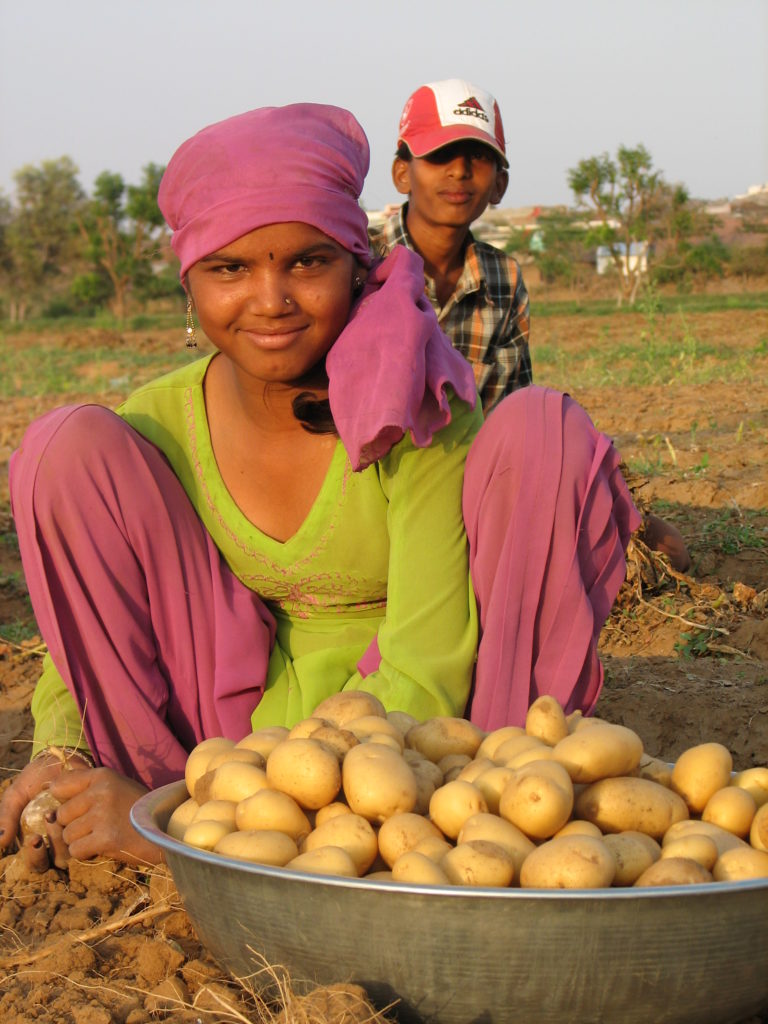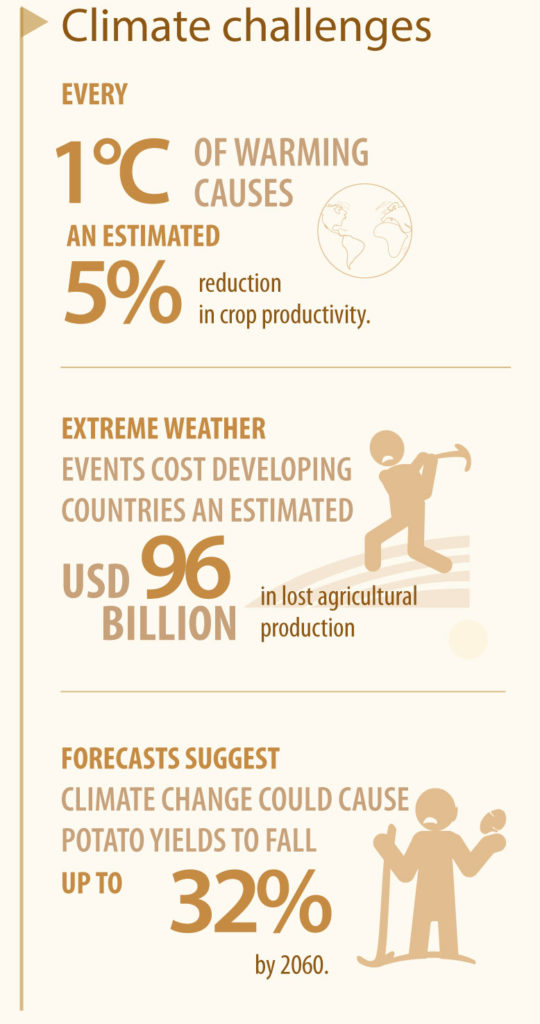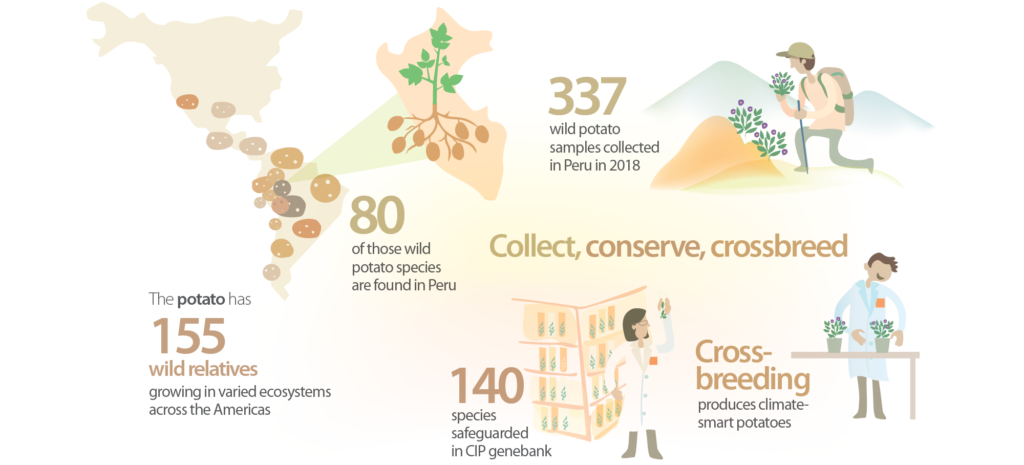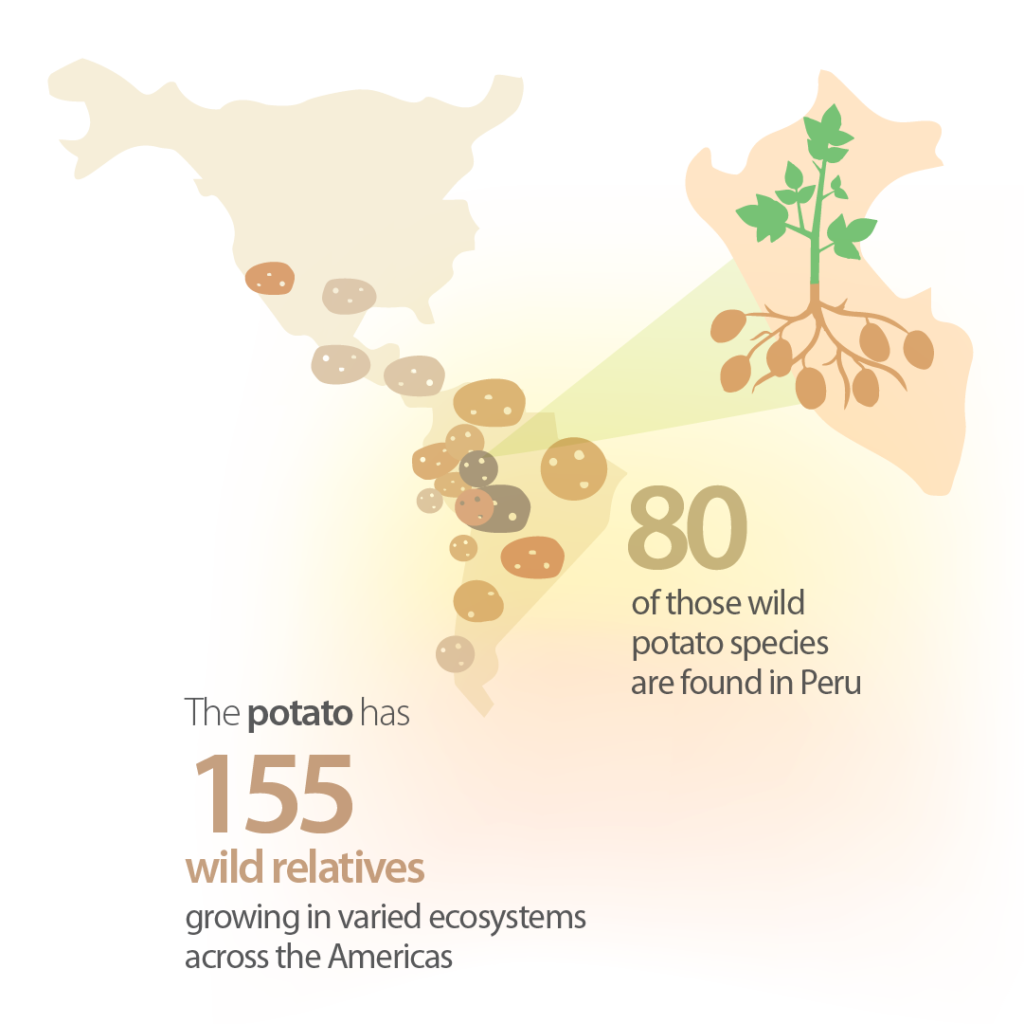Overview
- Agriculture is both vulnerable and a major contributor to climate change.
- Drought, flooding and rising temperatures associated with climate change will compromise expansion of potato and sweetpotato production.
- Potatoes and sweetpotatoes are relatively hardy and rapid-growing crops, and can play a key role in climate-smart agriculture.
- Next-generation technologies can be used to develop climate-smart varieties that mature quickly, resist many pests and diseases, and tolerate heat, drought or soil salinity to provide more nutritious food and better incomes in extreme climates.
- The International Potato Center (CIP) has also pioneered new agronomic techniques to improve the production of quality planting material.
- CIP seeks to accelerate the breeding and adoption of new climate-smart varieties and agronomic technologies.
- Investment priorities include:
- Agrobiodiversity conservation, use and evaluation of genetic resources;
- Tools and training for accelerated and demand-driven breeding;
- Enhanced inclusive and equitable seed system development;
- Promotion of climate-smart varieties among consumers and men and women farmers;
- Gender-responsive extension services to support farmers with quality planting material and training with climate-smart farming practices; and
- Improved training and technologies available to farmers, particularly women and other vulnerable groups.
Introduction
Agriculture contributes greatly to livelihoods and food security, yet it is both vulnerable to climate change and a major contributor to greenhouse gas. While food demand is expected to rise by 60% by 2050, every 1°C of warming is projected to cause an estimated 5% reduction in crop productivity. This process of climate warming will impact many factors related to food production, including soil salinization, heat and water stress, interrupted growing seasons, and greater incidence, intensity and distribution of extreme weather events and plant pests and diseases. Between 2005-15, extreme weather events cost developing countries an estimated USD 96 billion in lost agricultural production. Without action, potato yields could fall up to 32% by 2060.
Both potato and sweetpotato, the third and sixth most important food crops globally, have traits that breeders are using to develop climate-resilient varieties. Sweetpotato has greater heat tolerance and requires less rainfall than most staple crops, and drought-tolerant varieties often produce food when other crops wither and die. Early-maturing varieties are ready for harvest in less than four months, and their leaves can be eaten just two months after planting when food is scarce. Sweetpotato contributes to food security and the reduction of vitamin A deficiency, one of the most harmful forms of malnourishment for children under five and women of reproductive age. It can also be a healthy, cheap source of animal feed.
Consumed by over 1 billion people, about a third of potato production is undertaken by smallholder farmers. Early-maturing potato varieties can be ready to harvest three months after planting, providing food when grains are still green. This trait also allows potato to be incorporated into fallow periods of cereal-farming systems, which relieves pressure on scarce land and water resources and contributes to the sustainable intensification and diversification of agri-food systems.
Building blocks
Climate-smart varieties
Climate-smart varieties Dozens of CIP-bred, climate-smart potato and sweetpotato varieties have been released and are helping farmers cope with increasingly frequent weather extremes. Other varieties are currently in the pre-release phase. In 2011 and 2018, CIP and its partners produced the first reference genomes for potato and sweetpotato, which is allowing scientists to more accurately breed for climate-resilient traits.

Climate-smart potato varieties
Drought- and heat-tolerant Tacna and Unica potato varieties were evaluated in Peru’s coastal desert before being sent to China, where they became national varieties in 2006 and 2011, respectively. Able to grow in saline soils with a fraction of the water most potatoes need, they have enabled potato farming in regions, and seasons, where it is increasingly difficult to produce food. In 2015, both varieties were grown on a total of 250,000 hectares in China. Unica has also enabled farmers in dry regions of Kenya to grow potatoes, and is planted in the lowlands of Tajikistan in the months when it is too warm to grow wheat
Accelerated breeding
Faced with increasing climate change, scientists have accelerated the process of breeding and selecting potential climate-resilient varieties by using advanced genomic tools and simultaneous field trials in varied environments. These breeding tools are rapidly accelerating genetic gains. A proof-of-concept for a sweetpotato hybrid breeding scheme demonstrates that the time needed to achieve genetic gains can be reduced sevenfold. Genomic tools have facilitated development of a late-blight resistant potato in less than 10 years, something which scientists had been unable to achieve using conventional tools in over four decades.
In situ conservation and use of genetic resources
CIP works with communities in the Peruvian highlands to conserve the region’s potato agrobiodiversity in the field and periodically repatriates disease-free native potato varieties safeguarded in its genebank. A new initiative is studying the relationship between climate change, agrobiodiversity, and indigenous health and diets to identify prospects for more resilient agriculture in a changing climate.
Climate-smart seed systems
Access to quality potato or sweetpotato planting material of improved varieties boosts both harvests and the ability of households to adapt to extreme weather events. The development and functioning of climate-smart seed systems are essential in getting resilient varieties to farmers. Work with research institutes, and public and private sector partners has expanded the use of cutting-edge technologies to produce potato and sweetpotato seed, including sandponics, aeroponics and rooted apical cuttings. Nevertheless, there is still a great need for more quality planting material in Africa and Asia.
Surviving drought in Malawi
Loveness Kalira and her family were among the 300,000 households to receive planting material for climate-smart sweetpotato after a devastating drought in 2016 that left 6.5 million Malawians dependent on food aid. The following year, their sweetpotato crop thrived despite another drought that wiped out their maize harvest. Their sales of surplus sweetpotato allowed the Kaliras to purchase enough corn for the year and pay school fees for their four children.
Enhanced agronomic approaches
Scientists have developed and disseminated improved technologies and approaches to help farmers cope with challenges such as prolonged drought or increased pest and disease pressure. An example is the Triple S technique in which farmers store sweetpotatoes in sand during dry months and use them to produce vines for planting when rains resume. The method enables farmers to produce enough vines in time for early planting, which means they can harvest early when food is scarce and market prices are high.
Climate modeling tools
CIP tools support policymaking, priority setting and the deployment of mitigation strategies. Using satellite data to generate reliable long-term climate series, these tools include algorithms to generate rainfall and temperature data needed to model the impact of climate change on agriculture. They have enhanced the precision of crop modeling, yield forecasts, phenotyping and decision support systems. CIP crop management and ecology models have improved monitoring of pest population changes and assessment of late blight disease management scenarios.
Participatory varietal development and selection
Multi-disciplinary teams from CIP identify the varietal needs and preferences of men and women in target populations and work with crop breeders to incorporate those characteristics into climate-smart varieties. By actively soliciting farmer input on desired crop varieties, we can increase the probability that those varieties will be widely adopted.
Heat-tolerant early-maturing potato gains popularity among farmers in India
Potato is predominantly a winter crop in India. However, because it matures in just 90 days and can be planted in agroecologies where few other varieties thrive, the CIP-bred Kufri Lima variety, released in 2018, can be grown in the months between cereal harvests. This allows farmers to increase overall food production, compensating for rice and wheat yield losses due to climate change. Kufri Lima is also resistant to the most important potato viruses, which are aggravated by warming climates. This resistance allows farmers to select seed potatoes from their harvests rather than buying commercial seed potatoes each year.



